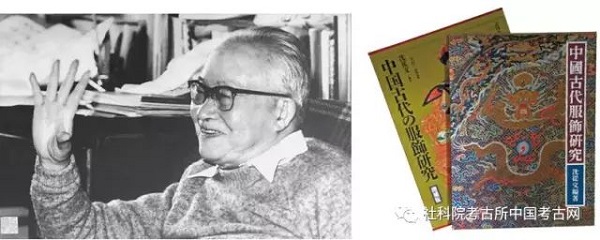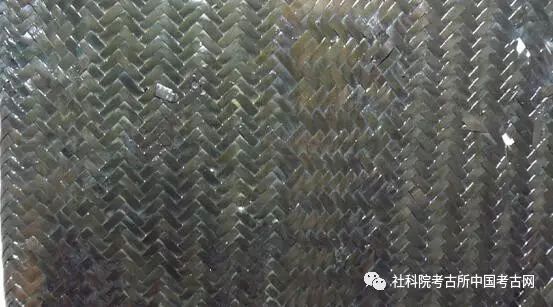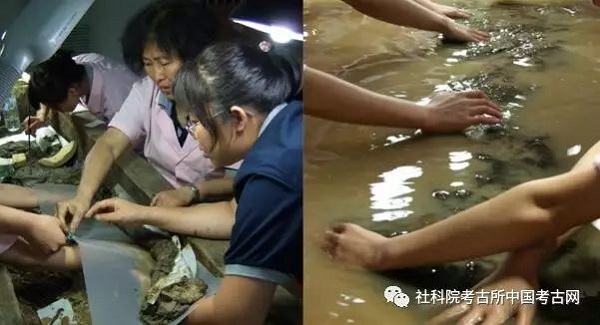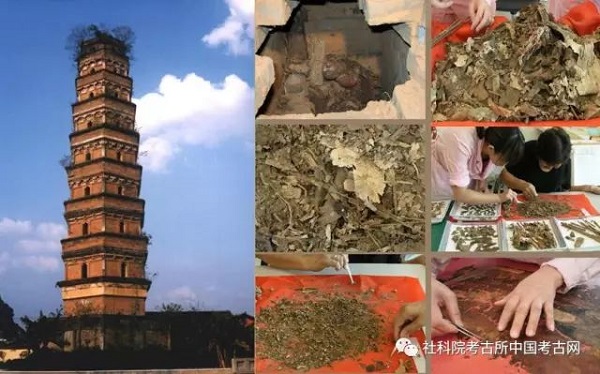As a novelist, Mr. Shen Congwen has another identity-a historian. Wang Yarong, a researcher at the Institute of Archaeology of the Chinese Academy of Social Sciences, is most familiar with Mr. Shen Congwen, who initiated the study of ancient Chinese costumes.
On September 8, 2017, Wang Yarong gave an academic lecture entitled "Shen Congwen and Ancient Costume Culture" at the Institute of Archaeology of the Chinese Academy of Social Sciences, introducing the development of textile archaeology from Mr. Shen Congwen to Mr. Wang and Mr. Wang Yarong, as well as the younger generation of textile archaeologists represented by Wang Jisheng, Si Zhiwen, Fu Meng and Jia Ting, and citing three textile archaeology in detail: the Eastern Zhou Tomb in Jing ‘an, Jiangxi, the Chu Tomb of Warring States No.1 in Mashan, Jiangling, Hubei, and the Tatonggong Hidden Shrine in Ciyun Temple in Ganzhou, Jiangxi.
In addition, Mr. Wang Yarong also put forward a general idea of "China Costume Museum".
Third from the left in the front row: Shen Congwen, fourth from the left: Wang Yarong.
First, the beginning of textile and apparel research work
China was the earliest country in the world to raise silkworms for reeling, and it was well-known in the world for its silk weaving skills in BC. Silk weaving penetrated into all aspects of ancient social life in China, and was applied to dress, home decoration and many other aspects. Textile cultural relics belong to organic matter, which makes it difficult to get the attention of cultural relics like bones, horns, teeth, jade, porcelain and bronze at the ideological level. As a result, with the subversive transformation of modern production methods, the traditional textile chain in China was almost completely broken, and the physical preservation time of textiles was only 100 years, which eventually led to the fracture of silk-weaving civilization in China.
(A) The publication of "Research on Ancient Chinese Costume"
In 1963, during his diplomatic visit, Premier Zhou Enlai found that China, which is famous for its silk weaving, had completely lost its own textile and clothing language, which formed a huge contrast in international exchanges. Therefore, he entrusted Mr. Shen Congwen with the task of completing the gift book of "Research on Ancient Chinese Clothing", which clearly defined the world cultural status of China’s textile culture.
Shen Lao himself recalled the beginning of "Research on Ancient Chinese Costume": "In the early spring and summer of 1960s, Premier Zhou Enlai and people from several cultural departments talked about going abroad every time, and they were often invited to visit clothing museums and wax museums in those countries, because they could represent the cultural development and technological level of this country. Generally speaking, their exhibitions are mostly materials from the Middle Ages to the 17th and 18th centuries. China has a long history and culture, and there are a lot of old and new materials. I wonder if it is possible to systematically compile some of these books and give them away as cultural gifts when going abroad in the future. At that time, Mr. Qi Yanming was the Deputy Minister of Culture, and I recommended it. "
Mr. Shen Congwen and A Study of Chinese Ancient Costume
After the turmoil in the 1960s and 1970s, until September 1981, the Chinese and Japanese versions of Research on Ancient Chinese Costume were finally published by the Hong Kong Branch of the Commercial Press, which was the pioneering work of the research on ancient Chinese Costume. At that time, Mr. Shen led Mr. Wang and I to proofread the manuscript in the office of Hong Kong Commercial Press. During this period, Mr. Shen Congwen also took time to visit his old friends Shang Chengzuo and Mr. Rong Geng at Sun Yat-sen University. At that time, the joyful scene of three wise men was very touching. On that day, Mr. Shang also wrote the title of the book "Research on Ancient Chinese Costume".
Mr. Shen Congwen (middle) and Mr. Rong Geng (right) and Shang Chengzuo (left)
(2) Get to know Mr. Shen Congwen
Mr. Shen Congwen’s interest in the study of cultural relics and historical materials began very early. From the 1930s, he paid special attention to various crafts in his hometown Miaoxiang, Xiangxi, and began to write some papers on textile archaeology in the 1940s. After liberation, because of the need of job change, he devoted himself to the research and preaching of cultural relics. Premier Zhou’s entrustment became an opportunity for Mr. Shen to devote more of his mind to the research work of "mutual proof of history and reality" in textile and apparel. For example, in 1953, Mr. Shen published an article on "Weaving Gold Brocade" in "New Observation", with more than 10,000 words, in which he put forward many new ideas that others did not pay attention to at that time. Among them, the naming and naming of many things was decided by Mr. Shen. For example, the concept of "jade clothes" that we are familiar with now comes from this article. Sure enough, the tomb of Liu Sheng, the king of Zhongshan Jing, and his wife Dou Wan in Mancheng, Hebei Province, which was excavated in 1968, has been unearthed, confirming Shen Lao’s inferential research.
As we all know, Mr. Shen Congwen’s research on ancient Chinese costumes encountered many problems and delayed a lot because of the times, but in the meantime, Shen Lao never stopped reading and pondering over documents and cultural relics. Mr. Wang and I got to know Mr. Shen in these turmoil and hardships, and were taught by him to invest in the research work of ancient Chinese costumes.
In the 1970s, the library was a deserted place, with only a few people all day. I got acquainted with Professor Yang Xianru, a good friend of Mr. Shen, from the Chinese Department of Renmin University of China, because I was looking for periodical materials in the Beijing Library. After knowing the information I was looking for, Professor Yang told Mr. Shen Congwen that I had the information I needed and warmly introduced me to Mr. Shen Congwen. In 1973, due to Mr. Shen’s lack of assistants, I hoped I could help him draw, so Mr. Shen asked me to "draw" the bear play of the five-bird play, which was advocated by Hua Tuo in the Western Han Dynasty, according to a group of pictures of gold and silver artifacts in People’s Pictorial. After reading it, Mr. Shen was very satisfied and thought that I understood his required intention. Since then, I have become a helper in the study of Mr. Shen’s material and cultural history.
Bear play of wuqinxi
In the 1970s, Mr. Shen continued to sort out the manuscript of "Research on Ancient Chinese Costume", and he never stopped studying various material and cultural history. But what Shen Lao is really most concerned about is how to spread the essence of national culture more, so from the beginning, his research method is "historical facts prove each other", and the goal is to make more people understand and narrow the distance with the essence of traditional culture through these studies after comparing the physical objects with the literature. Mr. Shen’s research has always been the pursuit of painting reproduction and physical evidence collection. My early work was also here. Since then, I have also entered the research of traditional textile and clothing culture until today.
(3) Initiating the cause of textile archaeology
In 1978, Mr. Shen was transferred to the Institute of History of China Academy of Social Sciences to establish a research room for ancient Chinese costumes. Proposed by Mr. Shen Congwen and approved by Dean Hu Qiaomu, Mr. Wang and I officially became Mr. Shen’s assistants, which initiated the study of textile archaeological cultural relics and advocated the materialistic method of "taking the history of physical evidence" to study clothing culture. Although Mr. Wang and I can’t compete with Mr. Shen, we did finish some work that Mr. Shen didn’t set foot in, which made the work of Mr. Shen in his later years smoother. The combination of our practice and Mr. Shen’s research benefited us greatly, which can be described as the great fortune of our generation.
When I assisted Mr. Shen’s clothing culture research in the early days, a series of work was initiated in China, which really improved the work content of China ancient textile clothing research, and I also engaged in clothing culture research all my life. This work is all the practice and research work of textile archaeology. It not only really perfects the research work of textile and clothing initiated by Mr. Shen, but also becomes the only China-specific branch of archaeology in China.
As the first practitioners of this work, I deeply felt the profound accumulation of ancient Chinese costume culture and history in practice, so I felt that my responsibility was great. As the staff at the archaeological site, they exercise the duty of protecting and studying cultural relics. The organic textile cultural relics that are difficult to be preserved are fragile and deteriorated. A slight mistake at the scene will destroy or mislead the direction of culture. It can be said that it is a big crime to see and not get them. More than forty years of first-line work experience, I dare not comment on others, but always introspect. In retrospect, I should have a clear conscience.
Mr. Wang and I participated in the excavation, protection and restoration of textiles, including Mawangdui Han Tomb in Changsha, Hunan Province, No.1 Chu Tomb in Jiangling Mashan, Jingzhou, Hubei Province, Tangta Palace in Famen Temple in Shaanxi Province, Liu Sheng Tomb in Zhongshan, Hebei Province, Dabaotai Han Tomb in Beijing and Guo Tomb in Sanmenxia, Henan Province. After Mr. Wang’s physical condition declined, I personally presided over the excavation, restoration, protection and research of many textile cultural relics, such as the Eastern Han Tomb in Niya, Minfeng, Xinjiang, the Han Tomb in Laoshan, Beijing, the Yuan Tomb in Yuanling, Hunan, the Tomb of Military Attaché in Shijingshan in Qing Dynasty, the Eastern Zhou Tomb in Jing ‘an, Jiangxi, the cultural relics in Ciyun Temple Tower in Ganzhou, Jiangxi, the cultural relics in Pigeon Cave in Longhua, Hebei, and the Liao Tomb in Yemaotai, Liaoning. These works gradually formed a relatively complete physical chain of textile cultural relics in China, which provided important evidence for the study of ancient Chinese costume culture, and also improved the protection of textile cultural relics and the research of technology in practice.
1995 is the 30th anniversary of Mr. Shen Congwen’s research on ancient Chinese costumes. With the support of Mr. Guo Hanying, the son of Guo Moruo, the Institute of History of China Academy of Social Sciences, a small commemorative exhibition was held in Guo Moruo’s former residence. The exhibition was very successful and won unanimous praise from leading experts from China Academy of Social Sciences, China Academy of Sciences, National Cultural Heritage Administration, Peking University, Tsinghua University and Beijing Institute of Fashion. At that time, Mr. Wang Renzhi, executive vice president of China Academy of Social Sciences, gave us eight words with great emotion after knowing our work situation in detail: hard work and bleak management.
Left one: Xinhua News Agency reporter, left two: Wang Yarong, left three: Mrs. Shen, right three: Wang, right two: Wang Zengqi, right one: Guo Hanying.
Second, the practice and research in the field of textile archaeology
Mr. Shen Congwen strongly advocated that the study of costume culture should make the past serve the present. Textile archaeological excavation and protection is to inherit the skills of China elements of our ancestors, and apply them to all aspects of modern social life. It is the closest research to modern social life to revitalize the study of China’s clothing culture and clothing. Therefore, under the guidance of Shen Lao, we pay special attention to the extension of textile and clothing research work. The following will give three examples to describe the situation of textile archaeological sites in recent years.
(1) Eastern Zhou Tomb in Jing ‘an, Jiangxi Province
Jing ‘an County, Jiangxi Province is located in Yichun City, northwest Jiangxi Province, 80 kilometers southeast of Nanchang. Jing ‘an County, Jiangxi Province has a high terrain in the west and a low terrain in the east, with mountains in the west and hilly plains in the east. The North River runs through the whole territory from west to east. Shuikou Township, where the Tomb of the Eastern Zhou Dynasty is located, is located ten kilometers west of the county seat, which is a transitional zone from hills to western mountains. Shuikou basin is about three kilometers long from east to west and two kilometers wide from north to south. The tombs of the Eastern Zhou Dynasty are located on the southern edge of the basin.
According to the relics collected from the Eastern Zhou Tomb in Jing ‘an, Jiangxi Province after being stolen, including silk fragments, National Cultural Heritage Administration approved the rescue excavation of the tomb, and informed me to participate in the rescue and protection of silk together with Jiangxi Institute of Cultural Relics and Archaeology. The tomb is a vertical hole tomb with earth pits, divided into three groups of 47 coffins, and there is almost no gap between coffins. Therefore, the primary problem faced by archaeological work is how to extract the coffin. Because the water level in the south is low and humid, and there is a lot of water in the coffin, siphon pumping is adopted. In order to prevent the silk in the coffin from being bumped and dislocated during transportation, it is coated with desized white cotton cloth. Then, we made a special iron carriage, transported the coffin to a large grain depot nearby for cleaning and disinfection as a temporary laboratory, and cooled the room temperature to 18℃ with ten air conditioners.

Eastern Zhou Tomb in Jing ‘an, Jiangxi Province
Because the bamboo mat wrapped the corpse is very fragile, the method of coiling was adopted, and at the same time, attention should be paid to water conservation. After extraction, it was found that the weaving technology of bamboo mats at that time was almost the same as that of modern times, and they were all "human" patterns.
Excavate the cleared bamboo mat.
In the process of cleaning silk fabrics, it was found that mud, sand and silk fabrics were mixed together, and those sands were very small, the largest of which was only the size of mung beans, so they were picked up one by one. Silk fabrics are also wrapped in soil, so it is impossible to judge the specific shape and appearance. Therefore, we decided to build a pool beside it, beat the water with our hands, and use the ripples of the water to swing out the mud. Every time we clean it, we need to change the water for 50 or 60 times. When the silk fabric is about to be cleaned, we need to slowly absorb the water and mud with a sponge. This process is very long. When the mud was completely cleaned up, the largest piece of textile unearthed from the coffin so far was obtained, and it was determined that the silk fabric was a square hole yarn of mulberry silk.
Excavation of the Eastern Zhou Tomb in Jing ‘an, Jiangxi Province-Pick-up and Cleaning of Textiles
The Eastern Zhou Tomb in Jing ‘an, Jiangxi Province, after two years of on-site rescue cleaning and protection, the earliest warp and brocade textiles in China have been discovered so far (most of the textiles we see now are weft-knitted). In this tomb, the square hole yarn, hunting brocade and geometric brocade of silk fabrics from the Eastern Zhou Dynasty were cleared up, among which the density of geometric double-color brocade fabric reached 240×10 pieces/cm2, which is quite high today. After preliminary research, all the tomb owners are women aged 15 to 25, but no jewelry has been found, which may not be the wife and concubine of the dignitaries, but the weaver of the nearby textile workshop. This excavation work successfully rescued the tombs and precious cultural relics of the Eastern Zhou Dynasty under protection, and obtained many empirical evidences of the costume culture of the Eastern Zhou Dynasty. This tomb of the Eastern Zhou Dynasty was rated as one of the top ten archaeological discoveries in China in 2007.

Original Jing Jin Unearthed from Eastern Zhou Tomb in Jing ‘an, Jiangxi Province
(2) Chu Tomb of Warring States Period No.1 in Mashan, Jiangling, Hubei.
Mashan No.1 Warring States Tomb in Jiangling, Hubei Province, which was cleaned in 1982, was in good sealing condition. Silk cultural relics were well preserved in the coffin. It was amazing at the beginning of the coffin opening, and it was very beautiful to see colorful embroidered quilts. But after a glance, Mr. Wang decided to immediately close the coffin and seal it and transport it back to the laboratory for further cleaning, so as to clean, protect and study it in a better environment.
It has been more than 30 years since the excavation of the tomb. Except for the excavation personnel, the cultural relics that people can see are all exhibits or pictures after excavation, and most people’s understanding of cultural relics is "second-hand" or incomplete. Mashan N10 (the tenth cultural relic of the inner coffin) has a scarf tapestry with a light yellow silk face tattooed by a phoenix flower. Most of the cultural relics can only see a positive image, and if we only take the picture data as the basis, we may get two restoration results. What is really noteworthy is that these two results seem to be consistent with the report in terms of patterns, colors, sizes, etc., so which is true or false? We then studied the back of two kinds of restored products, and finally confirmed the results according to the specific process techniques.
N10 phoenix bird flower tattooed on the No.1 Chu Tomb in Mashan, Jiangling (left: original copy, right: original copy)
It is worth paying attention to the collar of the cotton robe with light yellow silk face tattooed by the flowers of N10 phoenix bird at No.1 Chu Tomb in Mashan, Jiangling. The collar is a very regular geometric pattern, all of which are diamonds, while the pattern in the middle of the diamond is very elegant. For example, there is a carriage in the design, and the driver in blue is responsible for driving the carriage, and the yellow one is shooting an arrow with a bow and a standard behind it. Below the figure is a carriage, below which are wheels, and in front of which are galloping horses pulling carts. In the diamond on the right left of this set of hunting maps of horses and chariots, there is a beast with an arrow falling to the ground and looking back, and there is a running deer in front of the beast. In the diamond on the lower left of the hunting map of horses and chariots, there is a man twisting his body, holding a sword in his right hand and a shield in his left hand to fight the tiger opposite. In the diamond on the right side of the pattern, there is a man kneeling on the ground, fighting with a leopard with a dagger in his right hand, and there is a small hunting dog next to him. In this unit, which is only 6.8 cm wide and 17 cm long, the scene of ancient nobles shooting rich wolves and fighting tigers and leopards is shown. Only this deputy collar, an embroiderer needs to embroider for more than seven months, which shows the luxury of the king’s life at that time.
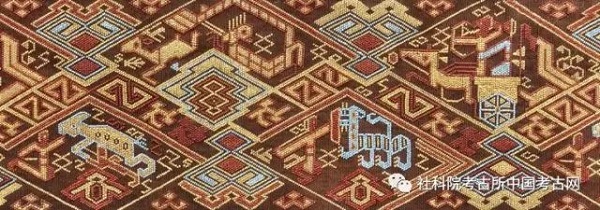
The hunting map of horses and chariots on the collar
Perhaps the above examples should make everyone feel that the real history of textile cultural relics is sometimes misunderstood blindly. Mashan Chu Tomb is the precious silk products of the Warring States period that we first saw and cleaned up. As practitioners who stripped, protected and recorded textiles, the seriousness and rigor of our work was obvious to all at that time. Even so, the understanding of the tapestry was not correct at the initial stage, and even the excavation report was mistakenly written as a tapestry.
There are also mistakes in many published materials, such as the unit pattern extraction of embroidered quilt in Mashan Chu Tomb. Except for the Study of Ancient Chinese Costume by Mr. Shen Congwen, even the Excavation Report of No.1 Chu Tomb in Mashan, Jiangling, Hubei Province by Cultural Relics Publishing House has deviations in the division of pattern units. This may also be related to the misunderstanding of cultural relics as the digger himself. The correction of these misunderstandings comes from Mr. Shen’s long-standing research requirements and his strong desire to reproduce historical truth.
In the 1970s, after completing the excavation of the Chu Tomb in Mashan, Jiangling, Hubei Province, I personally devoted myself to the vision of the reappearance of cultural relics after work. Under the extreme enthusiasm for the appearance of cultural relics more than 2,000 years ago, we overcame many difficulties, made a deeper interpretation of cultural relics again, and set out to copy the N10 robe of Mashan No.1 Chu Tomb. The robe has straight sleeves, wide cuffs and a right collar. The dress is complete with lock embroidery to complete the embroidery of phoenix flower pattern, and the collar edge field hunting tattoo decoration is completed with nano-embroidery technology. China’s traditional clothing with plane cutting has always had the effect of three-dimensional cutting, but at first glance, N10′ s underarm square insert did not know its function. However, after the recovery, wearing a belt, no matter what action the hand makes, the dress will not move, which is not only convenient for the action, but also maintains the etiquette of Jing Ya, which is worth learning from today.
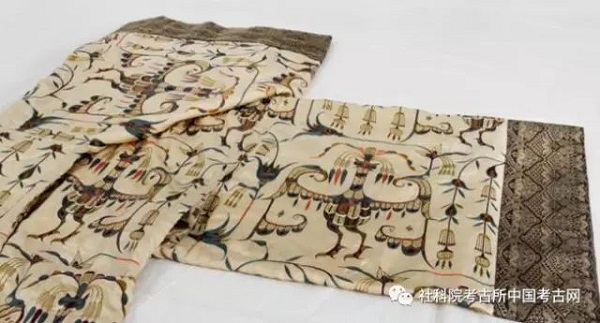
N10 garment replica of Mashan No.1 Chu Tomb
The pattern on N2 quilt of Mashan Chu Tomb is also very beautiful. For example, in the dragon and phoenix combination pattern, two S-shaped dragons are opposite, and the wind mouth holds the dragon’s tail, which makes the dragons seem to be struggling. In this batch of decorative patterns, the phoenix is at the top, either biting the dragon’s tail with its beak or stepping on the dragon with its foot. The whole pattern structure is very particular about dragons and phoenixes crisscrossing each other, turning left and right symmetrically, and staggered up and down by half a grid. All the patterns in the tomb are mainly dragons, phoenixes and tigers, and the phoenix has the upper hand, which seems to be related to the totem or belief of the Chu nationality at that time.
The dragon and phoenix combination pattern on the quilt of N2 in Mashan Chu Tomb
Mr. Shen was very pleased with the reproduction of the textile cultural relics of Mashan Chu Tomb. He even said that "the representative clothes that have been experienced for many years will be made one by one and displayed in a room, which is the China Costume Museum". Professor Zhang Guangzhi of Harvard pointed out with excitement: Your work is the reappearance of ancient costumes by using experimental archaeology research methods, which makes the latest research method that rose in the United States unexpectedly appear in China and try it in textile archaeology, a new discipline that has not been paid enough attention to. He encouraged me to keep going.
Since the successful excavation and publication of the cultural relics of Mawangdui Han Tomb in Hunan Province, important textile cultural relics have appeared in a series of tombs such as Mashan Chu Tomb in Jiangling, Hubei Province, Tangta Palace in Famen Temple in Shaanxi Province, Liu Sheng Tomb in Mancheng, Hebei Province, Dabaotai Han Tomb in Beijing, Yemaotai Liao Tomb in Liaoning Province, Guo Tomb in Sanmenxia, Henan Province, Niya East Han Tomb in Minfeng, Xinjiang, Laoshan Han Tomb in Beijing, and Dong Zhou Tomb in Jing ‘an, Jiangxi Province. Although we worked patiently, the method was not really taken seriously by the academic circles, and what remained was only the rotten and unrecognizable remains, which failed to make people intuitively understand silk cultural relics and left the world’s understanding of China’s silk weaving and clothing history in a gloomy impression. Although I feel deeply sorry and responsible, the busy work and limited funds have made the expansion of textile experimental archaeology expected by the old gentlemen come to a standstill.
(3) Hidden niche of Pagoda Temple of Ciyun Temple in Ganzhou, Jiangxi Province
May 26th, 2004. Ganzhou Museum in Jiangxi Province has been repairing the stupa of Ciyun Temple, and found a large number of broken cultural relics in the early years of the Northern Song Dynasty in the hidden niche on the fourth floor of the inner wall.
Ciyun Temple Tower in Ganzhou, Jiangxi Province and Unearthed Cultural Relics Fragments
The restoration of paper-based paintings and calligraphy unearthed from Ciyun Temple Tower is quite different from the traditional mounting and restoration technology of China paintings and calligraphy. It is a restoration and research work jointly completed by archaeological taxonomy, cultural relics protection technology and China painting research, which took five years to complete.
In the early stage of debris sorting, many pieces were sorted for the first time according to basic characteristics such as material and color by using the method of shape classification in archaeology. Then these sorted pieces of paper and silk cultural relics are selected and classified according to their artistic meaning, and the pieces are reassembled and selected with similar artistic meaning and gradually put together. After the initial splicing, more than 30 paintings of support in the Northern Song Dynasty were repaired by connecting and shaping with a single silk screen of silkworm, exposing the life paper after painting the heart is stuffy, absorbing water and discharging solid with the lining paper, scraping the damaged part along the edge of the defect, mending according to the contour of the defect, sticking the folding strips and other steps, and there were almost no such paintings handed down at that time. At that time, Mr. Su Bai, a famous archaeologist, shook his head and said, "I don’t understand, I don’t understand", and suggested that no experts should write conclusive opinions, and the archaeological report should publish the information completely, so that experts from various related fields can participate in the research.
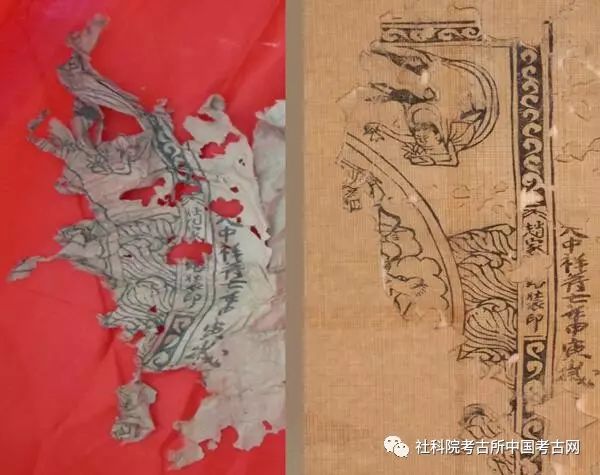
Before and after the restoration of the seven-year remnant of Dazhong Xiangfu
Third, the idea of establishing China Costume Museum.
Archaeological discoveries and documents in China record that Chinese’s clothing culture has evolved from the beginning to the world’s glory, and more than half a century’s scientific exploration of textile archaeology has also presented the world with a physical chain of clothing culture. From the ultra-fine bone needle of Xiaogushan discovered in Liaoning about 45,000 years ago to the textile machinery of Hemudu, to Mashan, Mawangdui, Famen Temple and Niya textile cultural relics, it eloquently shows the glory of China’s costume culture history. China’s sericulture and silk weaving technology is an important invention presented to the world.
Shen Congwen, a famous writer and cultural relic historian in China, was proposed by Premier Zhou Enlai half a century ago to create a precedent for the research and protection of China’s costume culture, and Shen Lao’s Study of Ancient Chinese Costume is a pioneering work in this field. Then, from Mawangdui Han Tomb, Mashan Chu Tomb, Famen Temple Underground Palace, Niya in Xinjiang, Laoshan in Beijing to Jing ‘an Tomb in Jiangxi, and so on, a series of major textile archaeological discoveries are amazing every time. In view of the limitation of fragile textile cultural relics preservation, Shen Congwen said to the embroidered cotton-padded clothes of the Warring States that we studied and copied: If we can do one thing when it is mature, every little makes a mickle, and it will be the "China Costume Museum" with a house on display. He also reported this idea to China Academy of Social Sciences and National Cultural Heritage Administration, but for various reasons, Shen Congwen and Mr. Wang failed to do so.
In the prosperous times, it will be a great event and a good deed to set up China Costume Museum. If people of insight unite with experts and scholars in the fields of archaeology, cultural preservation and textile, and combine with technical groups who have mastered traditional textile skills, on the basis of the research results and planning of the older generation of experts and scholars, and use the method of experimental archaeology to reproduce the true meaning of China’s costumes in a planned way, it should be the development direction and important measure of China’s costume culture to create a China costume museum integrating research, protection and inheritance.
China clothing museum should include the following functions:
1, textile archaeological excavation research and protection (to cooperate with qualified units), all kinds of textile processing technology research, protection and inheritance;
2. Holding an exhibition of textile archaeological discoveries;
3. Widely collect, protect and exhibit ancient textile cultural relics scattered in society;
4. On the basis of scientific research, high-level reproduction of fine clothing and cultural relics of past dynasties;
5, textile machinery (silk, twill, yee, brocade, velvet, satin, silk, makeup) into the display;
6. Printing and dyeing process (three series of plants, minerals and animals);
7. Silkworm reeling (simulated display);
8. Embroidery technology (process evolution and local characteristics);
9. Accessories (crown, boots and shoes, jewelry, quilt, accessories).
In a hurry for decades, Hua Fa is gray, recycled to the evening, and persisted with only a little persistence. Fortunately, I can say that I have a clear conscience about Mr. Shen. On the one hand, the research on China clothing initiated by Mr. Shen is advancing, and the spirit of Mr. Shen’s experimental archaeology has not been extinguished, and it is still quietly carried forward; On the other hand, through continuous efforts, Mr. Shen’s research has injected a lot of fresh blood and passed on in an orderly way. A young team of ancient textile protection research has basically matured and is growing day by day.
(Lecture draft finishing: Qin Chaochao)





